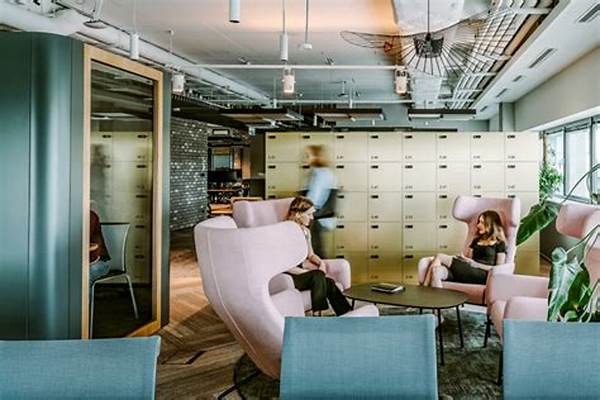H1: Deep Work Office Design
Read More : Deep Work Vs Shallow Work Which One Drives Results
In a world constantly buzzing with distractions, the concept of ‘deep work’—coined by productivity expert Cal Newport—emphasizes the importance of focused, undistracted periods of work for producing high-quality results. To enable such concentration, the environment plays a pivotal role. Enter the “deep work office design,” a concept that redefines traditional office spaces into sanctuaries of focus and productivity. Imagine stepping into an office where everything from the color of the walls to the placement of your desk has been meticulously crafted to minimize distractions and maximize productivity. This isn’t just wishful thinking—it’s a groundbreaking trend taking the corporate world by storm.
Deep work office design isn’t just about aesthetics; it’s about creating a symbiotic relationship between the user and the environment. An optimal design considers various elements like lighting, acoustics, furniture, and even the company culture. Natural light, for instance, has been proven to boost mood and alertness, making it a critical component of any deep work office. Soundproofing materials or even white noise machines can mitigate the disturbances that often disrupt focused work. Innovative furniture designs offer versatility, allowing for both seated and standing work, thus enhancing comfort and ergonomics.
Beyond the physical aspects, the deep work office design also aligns with the organization’s workflow and culture. For companies aiming to boost creativity and innovation, common areas that encourage brief, productive social interactions can be vital. Conversely, businesses with tasks requiring solitude and intense focus might opt for pod-like structures or individual booths. In essence, a deep work office isn’t a one-size-fits-all but a tailored solution that aligns with organizational goals and employee needs.
H2: Crafting the Perfect Deep Work Environment
The deep work office design revolutionizes how businesses approach productivity. It acknowledges that employees aren’t just robots performing tasks—they are dynamic individuals whose environment significantly impacts their performance. As more businesses recognize the value of deep work spaces, the demand for creative, flexible, and employee-centric designs will increase. The future belongs to those willing to rethink the office as a strategic tool for success, turning every workspace into a wellspring of productivity.
—H2: Discussing Deep Work Office Design
Embracing deep work office design is not merely a trend but a strategic shift that alters how we perceive workplaces. The essence of this design philosophy lies in creating an environment that not only fosters productivity but also stimulates well-being. But what are the fundamental building blocks of this design?
H3: The Psychological Impact of Space
Research indicates that workplace aesthetics significantly affect productivity and job satisfaction. The psychological impact of a well-designed space cannot be underestimated. Imagine entering an office where the color palette soothes the mind, the furniture cradles the body comfortably, and the overall layout encourages interaction without intrusion. Such spaces aren’t merely functional; they persuade and motivate employees to dive deeply into their work. This is the crux of deep work office design, where psychological factors are as important as physical ones.
Bright, natural lighting elevates mood and energy levels, while plants and natural elements reduce stress. Ergonomics play a vital role; a comfortable chair and an adjustable desk ensure that physical discomfort doesn’t become a distraction. By focusing on these elements, deep work office design becomes a driver of motivation and creativity.
Deep work office design also incorporates open spaces balanced with quiet zones. The fusion of collaborative areas with isolated spots allows employees the flexibility to choose their working environment based on the task at hand. This hybrid setup respects the diverse needs of a modern workforce, catering to both introverted and extroverted personalities.
By encouraging such flexibility, deep work office design not only enhances productivity but also cultivates a workplace culture rooted in freedom and autonomy. Employees feel empowered to tailor their environment, fostering a sense of ownership and responsibility.
H2: Goals of Deep Work Office Design
H2: Analyzing the Future of Deep Work Office Design
The future of office design isn’t just about aesthetics—it’s a functional, strategic approach that impacts productivity and employee satisfaction. Let’s delve into what the future might hold for deep work office design and how companies can prepare for these changes.
H3: Where Modern Meets Functionality
As we look to the future, it’s clear that personalization will continue to be a driving force in office design. Employees crave spaces that reflect their individuality, yet facilitate the deep, focused work required for innovation. The integration of technology will play an essential role. Smart offices equipped with IoT devices can offer real-time adjustments to lighting, temperature, and even desk height based on user preferences or activities, ensuring the environment continually adapts to their needs.
But modern functionality extends beyond technology. It also embraces sustainability. Environmentally responsible materials, energy-efficient lighting, and designs that allow for natural ventilation reflect an increasing awareness of our impact on the planet. Such features not only appeal to eco-conscious employees but also reduce operational costs in the long run.
Deep work office design will increasingly blur the lines between home and office. Remote work trends have emphasized the need for comfortable, flexible home office setups that mirror the benefits of a deep work-focused environment. Employers might offer stipends for home office improvements, ensuring employees have access to essential tools that make remote work equally productive.
Ultimately, the deep work office design of the future will acknowledge the hybrid work model—one that allows fluidity between different work environments, whether at home or in the office. Companies adopting this mindset will find themselves at the forefront of a workplace revolution, positioning themselves as attractive employers who care about employee well-being and success.
H2: Key Aspects of Deep Work Office Design
In summary, deep work office design is more than an aesthetic endeavor. It’s an investment in your team’s productivity and satisfaction. By tailoring environments to meet the diverse needs of a modern workforce, companies can harness the power of deep work, leading to greater innovation and success.


